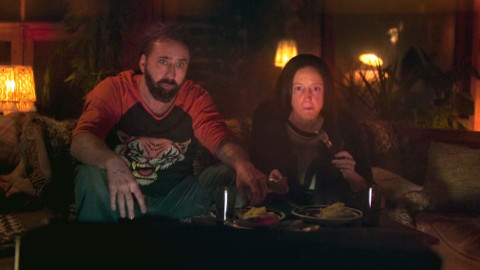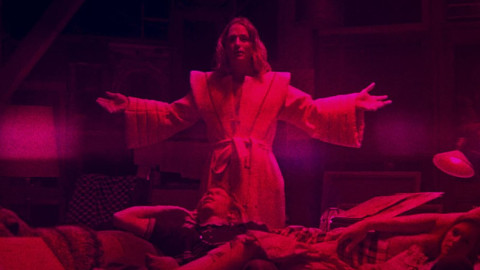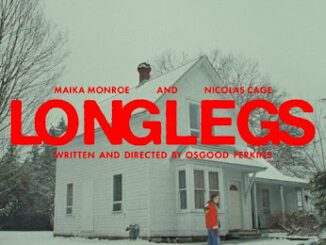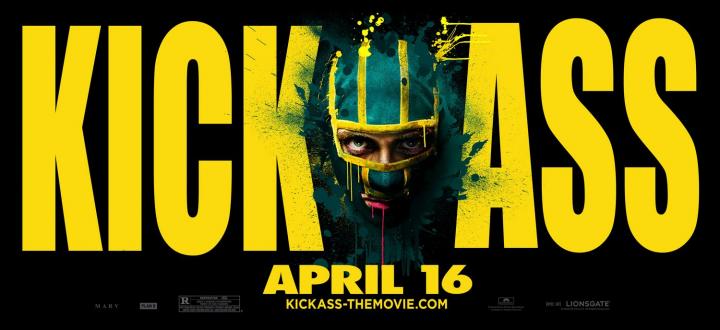Mandy (2018)
Directed by: Panos Cosmatos
Written by: Aaron Stewart-Ahn, Panos Cosmatos
Starring: Andrea Riseborough, Linus Roache, Ned Dennehy, Nicolas Cage
USA
AVAILABLE ON BLU-RAY AND DVD
RUNNING TIME: 121 mins
REVIEWED BY: Dr Lenera, Official HCF Critic
Somewhere near the Shadow Mountains in the year 1983, Red Miller lives with his girlfriend, artist Mandy Bloom, in a cabin near the lake. Red works as a logger, while Mandy has a day job as a cashier at a nearby gas station and creates elaborate fantasy art. On her way to work, Mandy is seen by Jeremiah Sand, leader of a hippie cult called the Children of the New Dawn. He gets Brother Swan to kidnap Mandy with the help of the Black Skulls, a demonic, cannibalistic, drug-consuming biker gang….
Art meets exploitation in what may be the ultimate example of style over substance. The simplest of revenge thrillers garnished with a few fantasy elements has been given an almost overpowering visual style influenced by artists like Frank Frazetta and J. M. W. Turner which both strengthens and weakens different aspects of the film. It’s been highly praised by many critics, though from what I can see audiences seem to be divided. One reason for the latter is that the ‘revenge’ part doesn’t begin until two thirds of the way through, leading many to probably consider much of what came before to be stretched out and even pointless. Indeed if you’re just after Nicolas Cage going full-on Cage on some bad guys then you’ll probably be disappointed at all the supposed filler. And the film doesn’t really provide the viewer with a sense of satisfaction during its vengeance wrecking, though that was probably intentional, a deliberate subversion of a genre that even being something of a fan I admit often encourages the basest feelings in those watching. On the other hand, I personally thought that Mandy was actually at its best before all that started, a combination of rather pure romance and druggy horror-tinged drama, from a director who seems to be shooting from a somewhat different state of consciousness to most of us but who is still able to inject some genuine soul into the piece. And we have here the best Cage performance in ages, maybe even since Leaving Las Vegas. I’m sure that some are still mocking it anyway because of the way many people sadly are now, but it really is a powerful, heartfelt one that knows when to be subtle as well as when to let rip.
About a third of the way through, having a King Crimson song open the film struck me as being absolutely perfect as Mandy sometimes seems like a King Crimson album visualised. An expressionistic montage first shows Red in a forest as a tree falls behind him, then in a helicopter when he refuses a drink. Is he a recovering alcoholic? Nothing concrete is said or shown, but both he and Mandy seem to be damaged souls who have found some measure of peace in each other and in retreating from the world. Mandy is introduced via expressionistic shots of her dark fantasy artwork which could possibly be her still working through a past trauma. Later on, she tells of how, when she was a kid, her father killed a baby starling after which her friends killed some more. But there seems to be the most subtle hint that that’s not all that went on during her childhood. Cinematographer Benjamin Loeb bathes the film in an intense red for many scenes right from the beginning, and after a switch to a cold blue for nighttime, there’s an absolutely gorgeous, lengthy shot of Red and Mandy in bed where blue outlines and flashes intrude on the predominantly red image. Despite all this visual stylisation, we get a real feeling of their love for each other, like an almost unbearably sweet shot of the two watching a cheapie B-movie [actually Don Dohler’s Nightbeast] in silence in the lounge at separate tables and not taking their eyes off the TV screen. It conveys far more than a load of soppy dialogue or even sex.
But their peace is soon going to be shattered when Mandy catches the eye of egotistical and sometimes out of control preacher and cult leader Jeremiah Sand. Cage was originally asked to play this role, and you can see how the character’s rants and bursts of aggression would have suited Cage who has very little dialogue as Red. However, Linus Roache does such a good job in the role that I can’t see how Cage could have done much better. Though clearly modeled on Charles Manson what with him being a failed musician, referring to his victims as “pigs”, and he and his cult’s use of psychedelic drugs, Sand is a frightening yet believable creation. He’s sadistic, arrogant yet also rather vulnerable and even petty. He’s really hurt when Mandy mocks a song he performs that he wrote himself. A brief glimpse of Mandy, nicely shown through several dissolves in slow motion ending on a freeze frame, is all it takes for him to fall in – well, I’m not sure it’s actually love as most of us see it – but for him it probably is. So he gets Brother Swan to pick up the Horn of Abraxus [there are several such grandly named things in the film] and call the Black Skulls. Their appearance, eerily announced by a van window opening and shutting, has a vivid nightmare feel about it even if demon biker gangs are hardly new. Details about these creatures remain vague and we don’t even see what they look like underneath their helmets, a brave but I guess good choice.
There’s an extremely frightening home invasion largely suggested by flickering lights, after which a stoned haze really does take over for a while. I’m sure that you know what happens to Mandy half way through, though I’m not going to describe it [which for a nice change isn’t rape] except that Red is forced to watch it. It should be a gut-wrenching scene, but the red lighting diffuses the intensity somewhat. In fact, after a while said red lighting, not to mention some smoke machines, get a bit monotonous and I began to long for the film to look different for a while, though it only does occasionally so. Soon after going through his horrific ordeal, we are treated to a heart-wrenching piece of acting from Cage when he goes home, pours some vodka over his wounds, drinks the rest of the bottle and howls like a wounded animal. I expect that the scene is already being laughed at and GIF-ed, but that would be deeply unfair. Seen in context, there’s nothing funny about it at all, and for those of us who’ve suffered some kind of major tragedy in our lives it’s also very relatable. This guy isn’t just grieving, he’s totally and utterly destroyed, and already we know that taking out the folk who did this won’t bring him much in the way of peace. On the other hand, we are later shown Cage attacking a bad guy crying: “You ripped my shirt”, which is clearly intended to cause a chuckle. By this time, Red’s a killing machine, wielding The Tainted Blade of the Pearl Night, an axe/sword/pike combo – plus a few other goodies given to him by none other than Bill Duke, the 75-year old actor barely having changed since the likes of Predator. He’s also just taken a load of liquid LSD, which I would have thought would have prevented him from carrying out his revenge with any degree of competency, though of course we’re hardly in anything resembling the real world by now.
We get a few delights as a chainsaw duel [though that’s hardly new, and the one in Tiger On The Beat is still the one to beat], but the early part of the film sets up expectation for some very crazy shit that doesn’t really materialise despite devices such as flashes of Heavy Metal-type animation including a direct reference to that film, and I personally expected more imagination once we got to the action. There’s a memorable death or two, but the blood seems to be of the crappy digital variety, a real shame considering that much of the druggy cinematography was done with methods like shooting through panes of glass with light reflections on them. The photography is also full of lovely long takes so we can really soak up the atmosphere and perhaps gets into a bit of a trance ourselves without the help of any naughty recreationals. There’s one long close-up which is almost heartbreaking where we actually see the lights go out from Red’s eyes. All this grim stuff still leaves some room for a few odd laughs, like Sand turning off the soundtrack music and the exchange: “We live just down near Crystal Lake”, “Oh that sounds lovely”. There’s several other direct film references to pick up on, plus some more high-brow ones like a variation on a quote from Joseph Campbell. These tend to just seem like an attempt to add some depth to the proceedings and therefore came across as a bit pretentious to this critic, though I expect that fans of the film are finding deep meanings in it anyway and that’s fine. I don’t really feel that the film should have only been an hour and a half rather than two hours like some, but we could have probably done with less of Sand’s monologues about himself and his ‘religion’ which are the same old stuff we’ve heard countless times before.
Mandy features the last score by the late Johann Johannsson, and his moody synths with some really violent noises at times make an important contribution. But in the end Mandy feels like several films trying to fight for dominance in its two hours and none of them really satisfying even though there’s still a great many things to appreciate along the way. Its dreamlike atmosphere and saturated look are genuinely intoxicating, but suggest that things are going to get hugely trippy and brain-screwing which by and large they don’t, partly because the story becomes more and more ordinary. Yet for something that either looks as if it’s two halves of two rather different films joined together, or one very generic one done in a very un-generic way, it still makes a strong impression and is certainly unlike much else that’s out there at the moment. Cosmatos certainly has a unique style and his apparently even weirder first feature Beyond The Black Rainbow will soon be watched by Yours Truly. And you probably won’t be able to get that Cheddar Goblin [honestly] advertisement out of your mind.










Be the first to comment